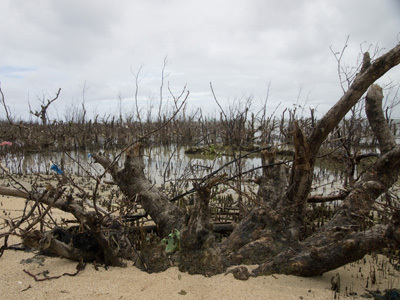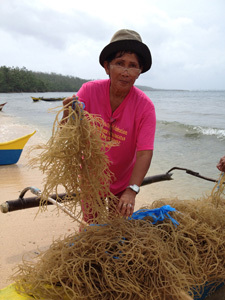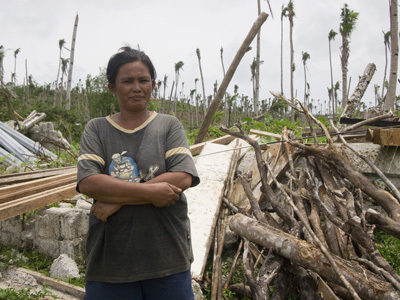As governments meet in Japan to hear new evidence from the International Panel on Climate Change (IPCC) which expected to show that the impact of climate change on food will be far more serious than previously thought, a new report from Oxfam warns that the impact of climate change could put back the fight against hunger by decades.
One country already feeling the impact is the Philippines. When Typhoon Haiyan hit the Philippines, in November 2013 -- the strongest storm ever to make landfall -- thousands were killed and millions lost their homes and livelihoods. Rice crops were ruined, 30,000 fishing boats destroyed and more than 33 million coconut trees flattened.

Destroyed mangroves, Hernani municipality, Eastern Samar
Fisherman, Mario Waniwan, spends much of his time sitting in his makeshift shelter on the beach with his wife and ten month old son, Marvin. He says that these days, no-one in his village, Batang, in Hernani Municipality, Eastern Samar, in the Philippines, is able to go fishing or catching a highly-prized local delicacy, mud crabs.
Tens of thousands of fisherfolk like 23 year old Mario lost their boats, nets and other equipment in the aftermath of typhoon Haiyan (known in the Philippines as Yolanda), the strongest storm to ever make landfall in the Philippines. But, to make matters even worse, the mangrove trees close to his village, where mud crabs and other sea creatures used to nest, have been totally destroyed by the sea surges and strong winds that typhoon Haiyan brought in its wake last November. It's a depressing scene of black, deadened shoots and withered branches.
Damaged coral reefs in other marine areas add to the problem. Fishermen and women in typhoon affected areas in the Philippines who have been able to return to fishing complain that their fish catches are much lower than before the typhoon; and that, as a result, they are also earning less.
Mario is struggling to feed his family and depends on relief aid.
"It's really a disaster what the typhoon has brought our family", Mario tells me. "There is no more fish. Catching mud crabs is [also] difficult. There are no more crabs because there are no more mangroves", he sighs.
"I don't have boats, fishing materials, or income for my family. It's not easy", he says. "And if the relief food stops, what will we do?"
Fisherman, Mario Waniwan
While the Philippines is no stranger to typhoons, rising sea levels due to climate change will very likely mean bigger storm surges during typhoons and tropical storms in the future. That could make it even harder for poor fishermen and women like Mario and subsistence farmers to feed their families.
In the fishing village of Ngolos, in Guiuan municipality, Eastern Samar, seaweed farmer, Dolores Mendez, is facing a similar plight. Her family used to earn about $100 dollars each month from seaweed farming
But the seaweed and all her equipment was destroyed by typhoon Haiyan. She's begun replanting, but says it will take several months before the family can harvest any crops again.
Seaweed farmer, Dolores Mendez
"The main source of our income was seaweed, but everything was destroyed by the typhoon", she said. "Even though my husband goes fishing, it's not enough because the catch is so low."
Aid agency, Oxfam, is supporting thousands of poor farmers and fishermen and women in the Philippines to get back feet, through various projects including repairing their boats and equipment, and giving them seeds and training.
One programme involves providing sawmills to local communities to help clear some of the millions of damaged and fallen coconut trees that litter the landscape, preventing farmers from being able to replant the trees as well as alternative crops.
That's benefitted farmers like 42 year old Armida Lacanaria. Falling coconut trees destroyed her house. She says she's now giving up on growing coconut trees as they take too many years to mature and bear fruit.
On her cleared land, she proudly shows me her healthy rows of cucumbers and some aubergines that are growing in vegetable trays.
"I will plant vegetables, because every 45 days I can harvest", she says.
Armida Lacanaria, standing beside her destroyed home
Even so, Armida complains that climate changes, bringing hotter then colder spells and more unpredictability, can make it hard to know when to plant the crops.
She points to rows of what were string beans, now brown and dry, which were ruined during two unseasonable tropical storms, shortly after typhoon Haiyan.
"Farmers like me we cannot be assured we always have a good harvest because of the climate.
"I need more help from the government; financial support for my family, to rebuild also my house, ...my plants, the seedlings...I need more help", she says.



